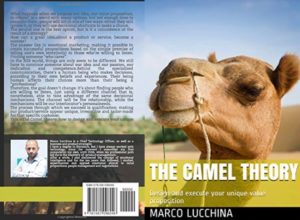CYBER
A new book, new research, two years of studying and writing.

The book aims to give a why to some facts: how human being are influenced by the digital word and if they are acting or not a primary role.
There is anyone who has established a new power? Higher than nations, constitutions, democracy and so on? A new international culture that will assimilate ours?
If you are interested in some answer, give a look.
THE CAMEL THEORY
Paperback and Kindle editions available on amazon.com, amazon.co.uk and amazon.it

What happens when we propose our idea, our value proposition, to others? In a world with many options, but not enough time to examine them, people will act in one of two ways: either they will ignore it, or they will use decisional shortcuts to make a choice.
The second one is the best option, but is it a coincidence or the result of a strategy?
How can a great idea, about a product or service, become a success?
The answer lies in emotional marketing; making it possible to create successful propositions based on the simple premise of telling one’s own story(only) to those who’re willing to listen. Finding someone “who cares”.
In the B2B world, things are only seem to be different. We still have to convince someone about our idea and our passion, our dedication and competence.Behind the specialized communication, there’s a human being who makes decisions, according to their own beliefs and experiences. Their being human affects their choices more than their being a “professional”.
Therefore, the goal doesn’t change: it’s about finding people who are willing to listen, just using a different channel that is, nonetheless, able to take advantage of the same decisional mechanisms. The channel will be the relationship, while the mechanisms will be our interlocutor’s personal needs.
The process through which we succeed is qualification: making our product/service appear unique, irresistible and tailor-made for that specific customer.
This isThe Camel Theory: how to design and execute your unique value proposition.




